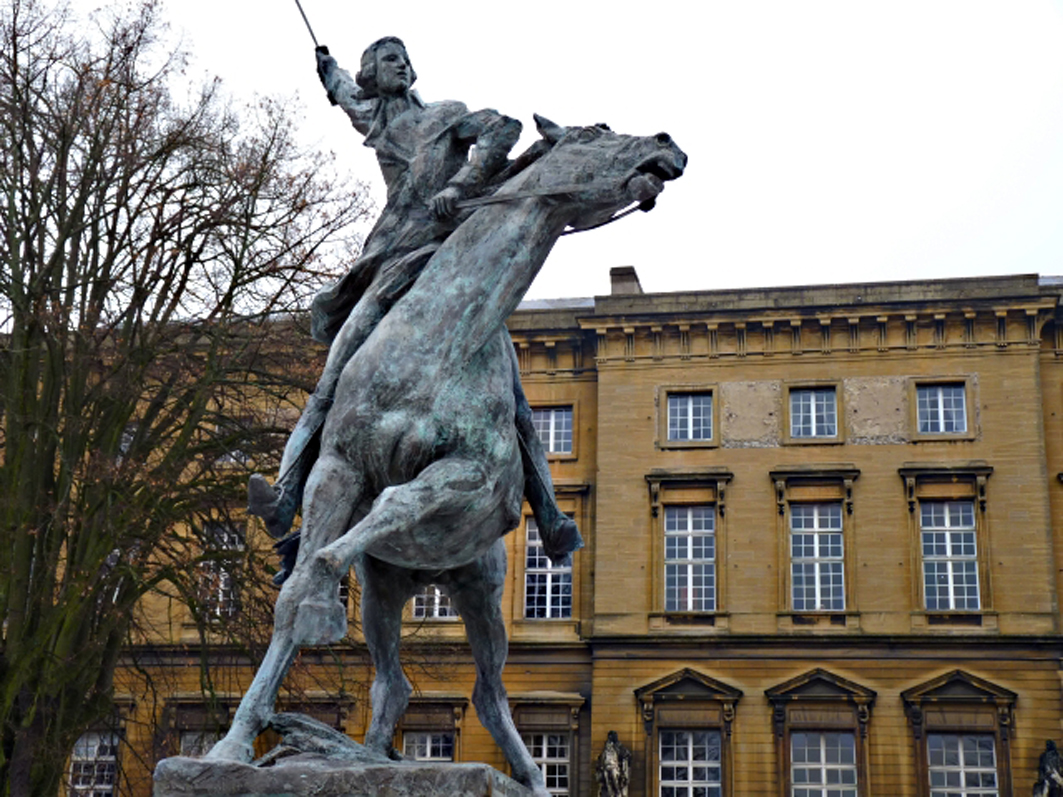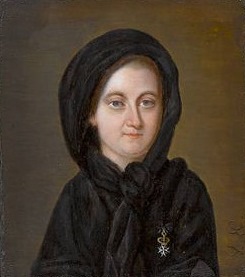|
Louis De Noailles, 4th Duke Of Noailles
Louis de Noailles, 4th Duke of Noailles (21 April 1713 in Versailles22 August 1793 in Saint-Germain-en-Laye) was a French peer and Marshal of France. Early life He was the son of Françoise Charlotte d'Aubigné, niece of Madame de Maintenon, and a nephew of Marie Victoire de Noailles, daughter-in-law of Louis XIV of France. Career Louis bore the title of Duke of Ayen until his father's death in 1766 when he became Duke of Noailles. He served in most of the wars of the eighteenth century without particular distinction but was nevertheless made a Marshal of France in 1775. He refused to emigrate during the Revolution, and died from natural causes in August 1793, thus escaping the fate of the guillotine. The duke's widow, granddaughter, and daughter-in-law were guillotined on 22 July 1794, twenty-five days after his brother and sister, sister-in-law, their daughter-in-law, and niece had met the same fate. Another granddaughter, Adrienne, wife of Gilbert du Motier, marquis de La ... [...More Info...] [...Related Items...] OR: [Wikipedia] [Google] [Baidu] |
Versailles
The Palace of Versailles ( ; ) is a former royal residence commissioned by King Louis XIV located in Versailles, Yvelines, Versailles, about west of Paris, in the Yvelines, Yvelines Department of Île-de-France, Île-de-France region in France. The palace is owned by the government of France and since 1995 has been managed, under the direction of the Ministry of Culture (France), French Ministry of Culture, by the Public Establishment of the Palace, Museum and National Estate of Versailles. About 15,000,000 people visit the palace, park, or gardens of Versailles every year, making it one of the most popular tourist attractions in the world. Louis XIII built a hunting lodge at Versailles in 1623. His successor, Louis XIV, expanded the château into a palace that went through several expansions in phases from 1661 to 1715. It was a favourite residence for both kings, and in 1682, Louis XIV moved the seat of his court and government to Versailles, making the palace the ''de fact ... [...More Info...] [...Related Items...] OR: [Wikipedia] [Google] [Baidu] |
Marie Victoire De Noailles
''Marie Victoire'' Sophie de Noailles, Countess of Toulouse (6 May 1688 in Versailles – 30 September 1766 in Paris), was a French noble and courtier. Her second spouse was Louis-Alexandre de Bourbon, comte de Toulouse, Louis Alexandre de Bourbon, Count of Toulouse, the youngest legitimized son of King Louis XIV of France and his maîtresse-en-titre, Françoise-Athénaïs, marquise de Montespan, Madame de Montespan. Early life Marie Victoire was born at Versailles (city), Versailles on 6 May 1688, as the younger daughter of Anne Jules de Noailles, the 2nd Duke of Noailles and his wife, Marie-Françoise :File:Armoiries_maison_de_Bournonville.svg, de Bournonville (1656-1748). She was the thirteenth of twenty children. Several of her sisters married into important French nobility, noble families in France. Her sister Marie Christine married Antoine V de Gramont, Antoine de Gramont, duc de Guiche in 1687. Another sister, Lucie Félicité, married the Victor-Marie d'Estrées, Maréch ... [...More Info...] [...Related Items...] OR: [Wikipedia] [Google] [Baidu] |
Jean De Noailles, 5th Duke Of Noailles
Jean de Noailles, 5th Duke of Noailles (''Jean Louis Paul François''; 26 October 1739, Paris20 October 1824) was a French nobleman and scientist. Early life Jean-Louis-Paul-François de Noailles was the son of Catherine de Cossé-Brissac and Louis, 4th duc de Noailles, a Marshal of France in 1775. His father was a nephew of Marie Victoire de Noailles, daughter-in-law of Louis XIV of France, and his paternal grandmother, Françoise Charlotte d'Aubigné, was a niece of Madame de Maintenon. He was in the army for a period. However, his eminence as a chemist gained him the election as a member of the French Academy of Sciences, Académie des sciences in 1777. He was also a Knight of Order of the Golden Fleece, Golden Fleece. He became Counts and dukes of Alençon, Duc d'Ayen in 1766 on his grandfather's death, and Duc de Noailles on his father's in 1793. Having emigrated in 1792, he lived in Switzerland until the Bourbon Restoration in France, Bourbon Restoration in 1814, when he to ... [...More Info...] [...Related Items...] OR: [Wikipedia] [Google] [Baidu] |
Catherine Françoise Charlotte De Cossé-Brissac
Katherine (), also spelled Catherine and other variations, is a feminine given name. The name and its variants are popular in countries where large Christian populations exist, because of its associations with one of the earliest Christian saints, Catherine of Alexandria. In the early Christian era it came to be associated with the Greek adjective (), meaning 'pure'. This influenced the name's English spelling, giving rise to variants ''Katharine'' and ''Catharine''. The spelling with a middle 'a' was more common in the past. ''Katherine'', with a middle 'e', was first recorded in England in 1196 after being brought back from the Crusades. Popularity and variations Anglophone use In Britain and America, ''Catherine'' and its variants have been among the 100 most popular names since 1880. Amongst the most common variants are ''Katherine'' and ''Kathryn''. The spelling ''Catherine'' is common in both English and French. Less-common variants in English include ''Katharine' ... [...More Info...] [...Related Items...] OR: [Wikipedia] [Google] [Baidu] |
James Monroe
James Monroe ( ; April 28, 1758July 4, 1831) was an American Founding Father of the United States, Founding Father who served as the fifth president of the United States from 1817 to 1825. He was the last Founding Father to serve as president as well as the last president of the Virginia dynasty. He was a member of the Democratic-Republican Party, and Presidency of James Monroe, his presidency coincided with the Era of Good Feelings, concluding the First Party System era of American politics. He issued the Monroe Doctrine, a policy of limiting European colonialism in the Americas. Monroe previously served as Governor of Virginia, a member of the United States Senate, U.S. ambassador to France and Britain, the seventh secretary of state, and the eighth secretary of war. During the American Revolutionary War, he served in the Continental Army. Monroe studied law under Thomas Jefferson from 1780 to 1783 and subsequently served as a List of delegates to the Continental Congress, ... [...More Info...] [...Related Items...] OR: [Wikipedia] [Google] [Baidu] |
Gilbert Du Motier, Marquis De La Fayette
Marie-Joseph Paul Yves Roch Gilbert du Motier de La Fayette, Marquis de La Fayette (; 6 September 1757 – 20 May 1834), known in the United States as Lafayette (), was a French military officer and politician who volunteered to join the Continental Army, led by General George Washington, in the American Revolutionary War. Lafayette was ultimately permitted to command Continental Army troops in the decisive Siege of Yorktown in 1781, the Revolutionary War's final major battle, which secured American independence. After returning to France, Lafayette became a key figure in the French Revolution of 1789 and the July Revolution of 1830 and continues to be celebrated as a hero in both France and the United States. Lafayette was born into a wealthy land-owning family in Chavaniac in the province of Auvergne in south-central France. He followed the family's martial tradition and was commissioned an officer at age 13. He became convinced that the American revolutionary cause was ... [...More Info...] [...Related Items...] OR: [Wikipedia] [Google] [Baidu] |
Adrienne De La Fayette
Marie Adrienne Françoise de Noailles, Marquise de La Fayette (2 November 1759 – 25 December 1807), was a French marchioness. She was the daughter of Jean de Noailles and Henriette Anne Louise d'Aguesseau. On 11 April 1774, she married Gilbert du Motier, Marquis de Lafayette, who left France in 1776 to volunteer in the American Revolutionary War where he served under General George Washington, then later became a key figure in the French Revolution of 1789. Early life and family They had four children: Henriette du Motier (15 December 1775 – 3 October 1777), Anastasie Louise Pauline du Motier (1 July 1777 – 24 February 1863), Georges Washington Louis Gilbert du Motier, (24 December 1779 – 29 November 1849), and Marie Antoinette Virginie du Motier (17 September 1782 – 23 July 1849). She was a great-granddaughter of Françoise Charlotte d'Aubigné, niece of Madame de Maintenon.. Imprisonment and planned execution In 1795, the Marquise de LaFayette was impr ... [...More Info...] [...Related Items...] OR: [Wikipedia] [Google] [Baidu] |
Anne De Noailles (1729–1794)
Anne d'Arpajon, comtesse de Noailles (''Anne Claude Louise d'Arpajon''; 4 March 1729 – 27 June 1794 Accessed 8 October 2008) was a French and court official. She served as the '''' of two Queens of France, and |
Philippe De Noailles, Duc De Mouchy
Philippe de Noailles, comte de Noailles and later prince de Poix, duc de Mouchy, and duc de Poix ''à brevêt'' (27 December 1715 in Paris27 June 1794 in Paris), was a younger brother of Louis de Noailles, and a more distinguished soldier than his brother. He was the son of Françoise Charlotte d'Aubigné, niece of Madame de Maintenon. Life He served at Minden and in other campaigns, and was made a marshal of France in 1775, on the same day as his brother. He was long in great favour at court, and his wife, Anne d'Arpajon, Comtesse de Noailles, was first lady of honour to Marie Antoinette, and was nicknamed by her Madame Etiquette. This court favor brought down punishment in the days of the French Revolution, and the old marshal, his sister, his wife, daughter-in-law and granddaughter were all guillotined on 27 June 1794. Twenty-five days later, the widow, daughter-in-law, and granddaughter of the 4th Duc de Noailles were also guillotined. The Comte de Noailles received the Span ... [...More Info...] [...Related Items...] OR: [Wikipedia] [Google] [Baidu] |
Guillotine
A guillotine ( ) is an apparatus designed for effectively carrying out executions by Decapitation, beheading. The device consists of a tall, upright frame with a weighted and angled blade suspended at the top. The condemned person is secured with a pillory at the bottom of the frame, holding the position of the neck directly below the blade. The blade is then released, swiftly and forcefully decapitating the victim with a single, clean pass; the head falls into a basket or other receptacle below. The guillotine is best known for its use in France, particularly during the French Revolution, where the revolution's supporters celebrated it as the people's avenger and the revolution's opponents vilified it as the pre-eminent symbol of the violence of the Reign of Terror. While the name "guillotine" dates from this period, similar devices had been in use elsewhere in Europe over several centuries. Use of an oblique blade and the pillory-like restraint device set this type of gui ... [...More Info...] [...Related Items...] OR: [Wikipedia] [Google] [Baidu] |




